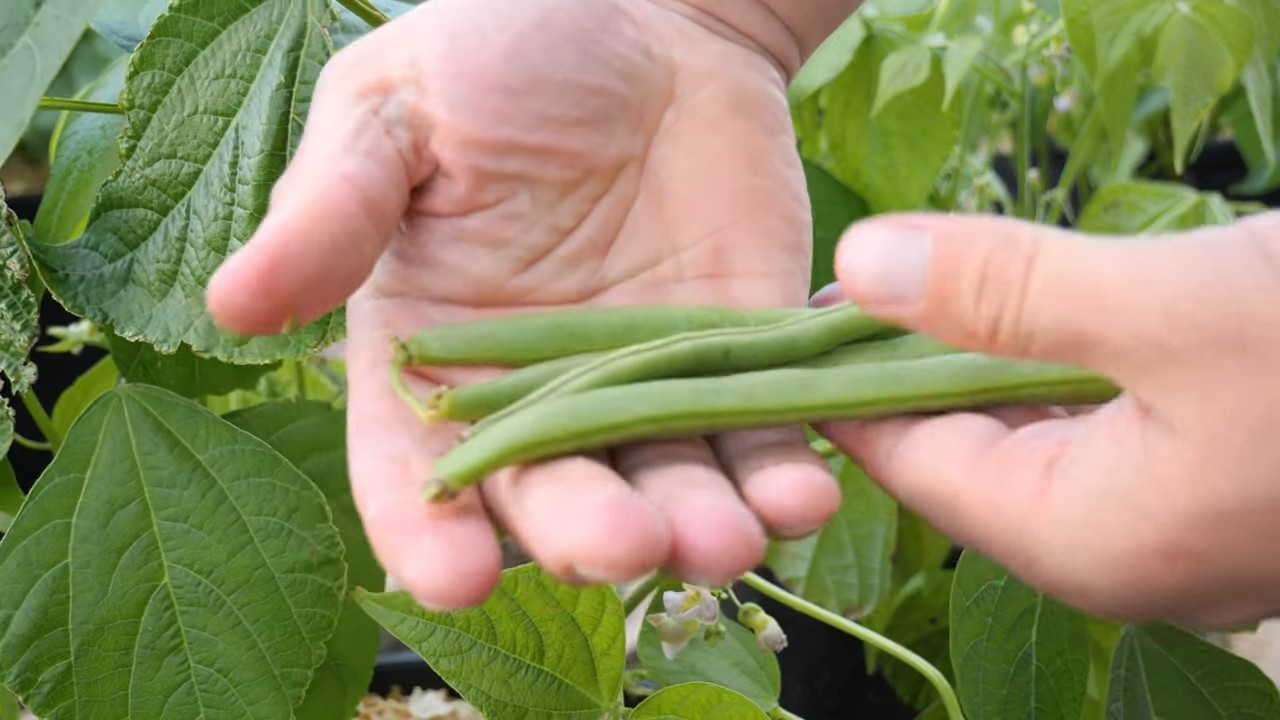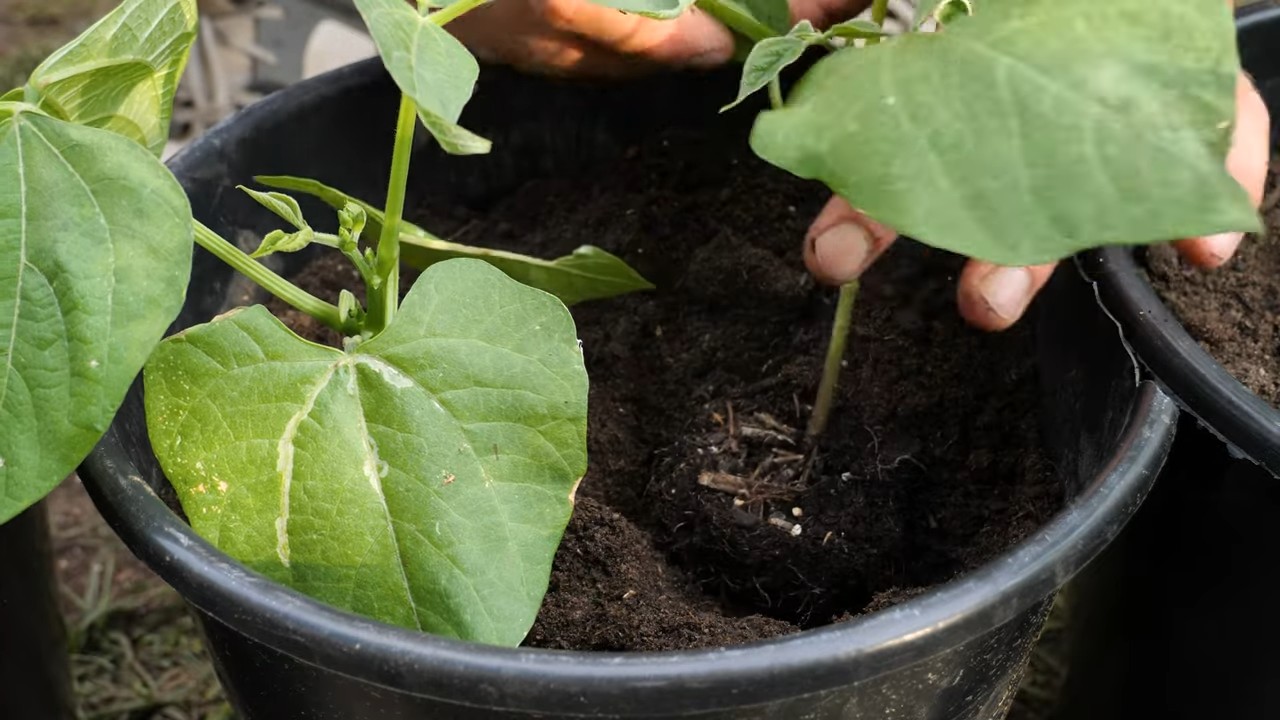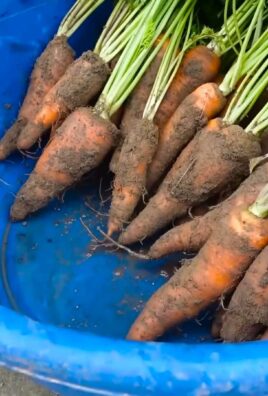Bush beans container gardening: it’s easier than you think! Imagine stepping outside your door and harvesting fresh, crisp bush beans, grown right on your patio or balcony. No sprawling garden needed! For centuries, humans have cultivated beans, with evidence suggesting their domestication dates back over 7,000 years in the Americas. From ancient civilizations relying on them as a staple food source to modern-day gardeners seeking fresh, homegrown produce, beans have always held a special place in our hearts (and diets!).
But let’s face it, not everyone has the space or time for a traditional garden. That’s where container gardening comes in! I’m going to show you how to successfully grow delicious bush beans in containers, even if you’re a complete beginner. This DIY guide is packed with simple tricks and hacks to ensure a bountiful harvest.
Why do you need this? Because store-bought beans simply can’t compare to the flavor and satisfaction of growing your own. Plus, it’s a fantastic way to connect with nature, reduce your carbon footprint, and enjoy fresh, healthy food. So, let’s dive into the world of bush beans container gardening and unlock the secrets to a thriving bean patch, right at your fingertips!

Growing Bush Beans in Containers: A Complete DIY Guide
Hey there, fellow gardening enthusiasts! I’m so excited to share my experience with growing bush beans in containers. It’s a fantastic way to enjoy fresh, homegrown beans even if you don’t have a sprawling backyard. Trust me, with a little know-how, you can have a bountiful harvest right on your patio or balcony. Let’s dive in!
Choosing the Right Container and Soil
First things first, we need to set the stage for our bean plants. The right container and soil are crucial for their success.
* Container Size: Bush beans don’t need a ton of space, but they do need enough room for their roots to spread. I recommend a container that’s at least 12 inches in diameter and 12 inches deep. This will give your plants enough room to thrive. You can use plastic pots, terracotta pots, or even repurposed containers like large buckets or tubs. Just make sure whatever you choose has drainage holes!
* Drainage: Speaking of drainage, this is non-negotiable. Beans hate sitting in soggy soil, which can lead to root rot. If your container doesn’t have drainage holes, you’ll need to drill some.
* Soil: Forget about using garden soil straight from the ground. It’s often too heavy and doesn’t drain well in containers. Instead, opt for a high-quality potting mix. Look for a mix that’s lightweight, well-draining, and contains ingredients like peat moss, perlite, or vermiculite. I personally love using a mix specifically formulated for vegetables.
Selecting Your Bush Bean Variety
Now for the fun part: choosing your bean variety! There are tons of different bush bean varieties to choose from, each with its own unique characteristics.
* Popular Varieties: Some of my favorites include ‘Blue Lake Bush,’ ‘Contender,’ ‘Provider,’ and ‘Bush Kentucky Wonder.’ ‘Blue Lake Bush’ is known for its excellent flavor and high yields. ‘Contender’ is a reliable producer and is resistant to some common bean diseases. ‘Provider’ is an early-maturing variety, perfect if you’re impatient like me! ‘Bush Kentucky Wonder’ has a classic bean flavor and is great for canning or freezing.
* Consider Your Climate: When choosing a variety, consider your local climate. Some varieties are more heat-tolerant than others, while others are better suited for cooler climates. Check the seed packet or online descriptions for information on the best growing conditions for each variety.
* Seed Source: Always buy your seeds from a reputable source. This will ensure that you’re getting high-quality seeds that are likely to germinate.
Planting Your Bush Beans
Alright, let’s get our hands dirty! Planting bush beans is a breeze.
1. Prepare Your Container: Fill your container with the potting mix, leaving about an inch or two of space at the top. Gently pat down the soil.
2. Sow the Seeds: Sow the bean seeds directly into the soil, about 1 inch deep and 2-3 inches apart. You can plant multiple seeds in the same container, but be sure to give them enough space to grow.
3. Water Thoroughly: After planting, water the soil thoroughly until it’s evenly moist. Be careful not to overwater, as this can cause the seeds to rot.
4. Provide Sunlight: Place your container in a location that receives at least 6-8 hours of sunlight per day. Bush beans need plenty of sunlight to thrive.
5. Germination: Be patient! Bean seeds typically germinate in 5-10 days, depending on the temperature and moisture levels. Keep the soil consistently moist during this time.
Caring for Your Bush Bean Plants
Once your bean plants have sprouted, it’s important to provide them with the care they need to grow strong and healthy.
* Watering: Water your bean plants regularly, especially during hot, dry weather. The soil should be consistently moist, but not soggy. Check the soil moisture by sticking your finger into the soil. If the top inch feels dry, it’s time to water.
* Fertilizing: Bush beans are relatively light feeders, but they will benefit from occasional fertilization. Use a balanced fertilizer, such as a 10-10-10, diluted to half strength. Fertilize every 2-3 weeks during the growing season. Alternatively, you can use a liquid seaweed fertilizer, which is a great source of micronutrients.
* Support: Bush beans typically don’t need staking, but if your plants are getting tall and leggy, you may want to provide some support. You can use small stakes or a tomato cage to help keep the plants upright.
* Pest Control: Keep an eye out for common bean pests, such as aphids, bean beetles, and spider mites. If you spot any pests, you can try spraying them with insecticidal soap or neem oil. You can also handpick the pests off the plants.
* Weed Control: Keep your container free of weeds. Weeds can compete with your bean plants for nutrients and water. Hand-pull any weeds that you see.
Harvesting Your Bush Beans
The moment we’ve all been waiting for: harvesting!
* Timing: Bush beans are typically ready to harvest about 50-60 days after planting. The pods should be firm, plump, and snap easily when bent. Don’t let the pods get too large or tough.
* Harvesting Technique: To harvest your beans, gently snap the pods off the plant. Be careful not to damage the plant. Harvest regularly to encourage continued production.
* Storage: Freshly harvested bush beans are best eaten right away. However, you can store them in the refrigerator for a few days. To store them, place the beans in a plastic bag and keep them in the crisper drawer. You can also freeze or can your bush beans for longer storage.
Troubleshooting Common Problems
Even with the best care, you may encounter some problems while growing bush beans. Here are a few common issues and how to address them:
* Yellowing Leaves: Yellowing leaves can be caused by a variety of factors, including overwatering, underwatering, nutrient deficiencies, or pests. Check the soil moisture and adjust your watering accordingly. Fertilize your plants with a balanced fertilizer. Inspect the plants for pests and treat them as needed.
* Lack of Flowers: If your bean plants are not flowering, it could be due to a lack of sunlight, excessive nitrogen fertilization, or high temperatures. Make sure your plants are getting enough sunlight. Avoid over-fertilizing with nitrogen. If the weather is too hot, try providing some shade during the hottest part of the day.
* Poor Pod Production: Poor pod production can be caused by a variety of factors, including poor pollination, nutrient deficiencies, or pests. Make sure your plants are getting enough sunlight and water. Fertilize your plants with a balanced fertilizer. Inspect the plants for pests and treat them as needed. You can also try hand-pollinating the flowers by gently shaking the plants.
* Root Rot: Root rot is a fungal disease that can occur when the soil is too wet. To prevent root rot, make sure your container has good drainage and avoid overwatering. If you suspect root rot, you can try transplanting the plant into fresh soil.
Maximizing Your Harvest
Want to get the most out of your bush bean plants? Here are a few tips:
* Succession Planting: Plant new seeds every 2-3 weeks to ensure a continuous harvest throughout the growing season.
* Companion Planting: Plant bush beans alongside other vegetables that can benefit them, such as carrots, cucumbers, and marigolds. Marigolds help deter pests.
* Deadheading: Remove any dead or dying leaves or flowers to encourage new growth.
* Proper Spacing: Make sure your plants have enough space to grow. Overcrowding can lead to reduced yields and increased disease risk.
Enjoying Your Homegrown Bush Beans
There’s nothing quite like the taste of fresh, homegrown bush beans. You can enjoy them in a variety of ways:
* Steamed or Boiled: Simply steam or boil the beans until they’re tender-crisp. Season with salt, pepper, and a little butter or olive oil.
* Sautéed: Sauté the beans in a pan with garlic, onions, and other vegetables.
* In Salads: Add cooked bush beans to salads for a boost of flavor and nutrition.
* Pickled: Pickle your bush beans for a tangy and delicious treat.
* Frozen or Canned: Preserve your bush beans for later use by freezing or canning them.
Growing bush beans in containers is a rewarding experience that anyone can enjoy. With a little planning and care, you can have a bountiful harvest of fresh, delicious beans right at your fingertips. Happy gardening!

Conclusion
So, there you have it! Growing bush beans in containers is not just a possibility; it’s a pathway to fresh, homegrown goodness right at your fingertips. We’ve explored the simple steps, from selecting the right container and soil to nurturing your plants and harvesting your bounty. But why is this DIY trick a must-try?
Firstly, it democratizes gardening. You don’t need acres of land to enjoy the satisfaction of growing your own food. A sunny balcony, a patio, or even a well-lit deck can become your personal bean farm. This accessibility makes fresh, healthy produce available to everyone, regardless of their living situation.
Secondly, container gardening offers unparalleled control. You dictate the soil quality, the watering schedule, and the plant’s environment. This control translates to healthier plants, fewer pests, and ultimately, a more abundant harvest. You can tailor the conditions to perfectly suit your bush beans’ needs, maximizing their potential.
Thirdly, it’s incredibly rewarding. There’s something deeply satisfying about watching a tiny seed sprout, grow, and eventually produce delicious, crisp beans. It’s a connection to nature that’s often missing in our modern lives, and it’s a fantastic way to de-stress and reconnect with the earth.
But the beauty of this DIY approach lies in its adaptability. Feel free to experiment with different varieties of bush beans. Try ‘Blue Lake Bush’ for its classic flavor, ‘Contender’ for its early yield, or ‘Provider’ for its resilience. You can also companion plant with herbs like basil or marigolds to deter pests and enhance the flavor of your beans. Consider adding a small trellis or support structure, even though bush beans are naturally compact, it can help keep the plants upright and prevent the beans from touching the soil.
Don’t be afraid to get creative with your container choices. While a standard pot works perfectly well, you can also repurpose old buckets, tubs, or even grow bags. Just ensure that your chosen container has adequate drainage to prevent waterlogging.
We wholeheartedly encourage you to give this DIY trick a try. It’s a simple, affordable, and incredibly rewarding way to enjoy fresh, homegrown bush beans. And once you’ve experienced the joy of harvesting your own beans, we’re confident you’ll be hooked!
More importantly, we want to hear about your experiences! Share your tips, tricks, and triumphs in the comments below. What varieties of bush beans did you grow? What challenges did you face, and how did you overcome them? Your insights can help other aspiring container gardeners succeed. Let’s build a community of bean-growing enthusiasts and share the joy of homegrown goodness! So, grab a bag of seeds, a pot, and some soil, and get ready to embark on your own container gardening adventure. Happy growing!
Frequently Asked Questions (FAQ)
What is the best size container for growing bush beans?
A container that is at least 12 inches in diameter and 12 inches deep is generally recommended for growing bush beans. This size provides enough space for the roots to develop properly and allows for adequate drainage. You can grow several plants in a larger container, but be sure to space them appropriately to avoid overcrowding. Overcrowding can lead to reduced yields and increased susceptibility to diseases. A good rule of thumb is to allow at least 4-6 inches between plants.
What type of soil should I use for container-grown bush beans?
Use a high-quality potting mix specifically formulated for containers. Avoid using garden soil, as it can become compacted in containers and doesn’t drain well. A good potting mix will be lightweight, well-draining, and rich in organic matter. You can also amend your potting mix with compost or other organic materials to improve its fertility and water retention. Look for potting mixes that contain ingredients like peat moss, perlite, vermiculite, and composted bark.
How often should I water my container-grown bush beans?
Water your bush beans regularly, especially during hot, dry weather. The soil should be kept consistently moist but not waterlogged. Check the soil moisture level by sticking your finger about an inch into the soil. If it feels dry, it’s time to water. Water deeply, until water drains out of the bottom of the container. Avoid watering the foliage, as this can encourage fungal diseases. Morning is the best time to water, as it allows the foliage to dry out before nightfall.
How much sunlight do bush beans need?
Bush beans need at least 6-8 hours of direct sunlight per day to thrive. Choose a location for your container that receives plenty of sunlight. If you live in a very hot climate, you may need to provide some afternoon shade to prevent the plants from overheating. Insufficient sunlight can lead to leggy growth, reduced yields, and increased susceptibility to pests and diseases.
Do I need to fertilize my container-grown bush beans?
Yes, fertilizing is important for container-grown bush beans, as the nutrients in the potting mix will eventually be depleted. Use a balanced fertilizer, such as a 10-10-10 or 5-10-5, according to the package directions. You can also use an organic fertilizer, such as compost tea or fish emulsion. Fertilize every 2-3 weeks during the growing season. Avoid over-fertilizing, as this can lead to excessive foliage growth and reduced bean production.
What are some common pests and diseases that affect bush beans?
Common pests that affect bush beans include aphids, bean beetles, and spider mites. Common diseases include powdery mildew, bean rust, and anthracnose. Inspect your plants regularly for signs of pests or diseases. If you find any, take action immediately to control them. You can use insecticidal soap or neem oil to control pests, and fungicides to control diseases. Good air circulation and proper watering practices can also help prevent pests and diseases.
When should I harvest my bush beans?
Bush beans are typically ready to harvest about 50-60 days after planting. Harvest the beans when they are firm, crisp, and about the size of a pencil. Pick the beans regularly to encourage continued production. Overripe beans will become tough and stringy. The best time to harvest is in the morning, when the beans are cool and crisp.
Can I grow bush beans indoors?
While it’s possible to grow bush beans indoors, it can be challenging. They require a lot of sunlight, so you’ll need to provide supplemental lighting. You’ll also need to ensure that the plants are properly pollinated. Hand-pollinating the flowers with a small brush can help. Indoor growing can be more susceptible to pests and diseases due to the controlled environment.
What are some good companion plants for bush beans?
Good companion plants for bush beans include basil, marigolds, rosemary, and carrots. Basil and marigolds can help deter pests, while rosemary can improve the flavor of the beans. Carrots can help loosen the soil and improve drainage. Avoid planting bush beans near onions or garlic, as these can inhibit their growth.
Can I save seeds from my bush beans?
Yes, you can save seeds from your bush beans, but only if you are growing heirloom or open-pollinated varieties. Hybrid varieties will not produce true-to-type seeds. To save seeds, allow some of the beans to dry completely on the plant. Once they are dry, remove the seeds from the pods and store them in a cool, dry place.




Leave a Comment